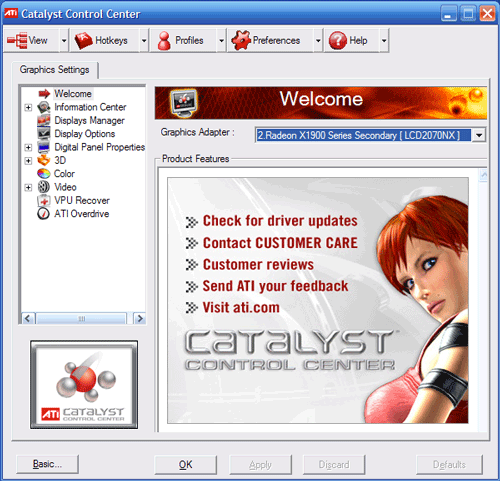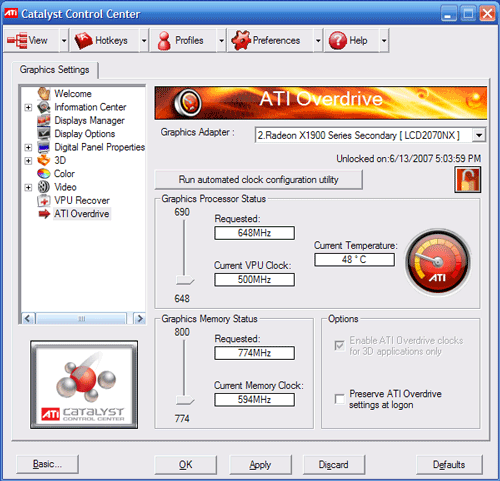Getting the Most Out Of Your Hardware: Video Card Utility Roundup
by Ryan Smith on July 5, 2007 12:00 PM EST- Posted in
- GPUs
ATI Catalyst Control Center
We'll begin with utilities for ATI video cards. ATI was the first to take significant flak for their utilities, as the Catalyst Control Center replaced the absolutely dainty ATI Control Panel. Running off of the heavier .Net framework, ATI introduced several new features that weren't previously possible in their control panel, at a cost of memory usage and load times an order of magnitude over the older control panel. Since its initial release ATI has worked on lightening the Catalyst Control Center, including a significant revision with the recent 7.3 Catalyst driver set that saw its performance improve a good deal. While still not in any way a dainty utility (it weighs in at 12MB on our test system when inactive, 46MB while active) it's not nearly the hulk it once was, but it will always be the textbook example of how to not go about building a video card utility.
As we previously mentioned, because the Catalyst Control Center is a first-party application it has been tuned both for basic users and advanced users, going so far as having two separate UI configurations based on user selection. The advanced UI is very straightforward, and the feature set is fairly standard with controls for monitors, 3D settings, overclocking, and others.

On the whole however, the Catalyst Control Center is fairly mediocre when trying to do anything beyond the basics; and we'll use this to lay out the criteria for the rest of the article for what we consider important features in a video card utility. It's best at making single-time changes such as changes to monitor settings, where it offers excellent controls for monitor alignment and overscan control, or adjusting AVIVO color & quality settings. In the middle is the 3D settings controls; the example graphic offered does a good job showing the effects of various settings and the optional taskbar menu makes adjusting settings fast, but it's still missing a few tweaks even in advanced mode that would be useful to have such as triple buffering for Direct3D games (oddly enough it supports triple buffering for OpenGL, but not the more popular D3D).
Where the Catalyst Control Center falters is in hardware monitoring, 3D settings profiles, and overclocking, all of which get picked up by third utilities. For hardware monitoring, the only degree of monitoring offered is a gauge showing the current core temperature, which is woefully inadequate, the lack of a chart or some other record of even just the temperature makes it hard to diagnose how the card is performing when it's running a game.
Of course such simple hardware monitoring is coupled with simple overclocking; while the Catalyst Control Center doesn't offer a ton of features and we wouldn't expect it given the potential for damage, even what it does offer is too conservative. When used with an X1900 XTX, we can only take the card from the stock of 650/1550 to 690/1600, a 6%/3% overclock respectively. This is so low that it's below what the card is factory-tested for: 700/1700 and as a result we'd have to use a third-party utility just to hit its rated speeds. We understand ATI's need to keep people from damaging their cards with the Catalyst Control Center, but a 3% limit to memory overclocking in particular is so low that any difference it would make would be negligible in the first place.

Last, 3D settings profiles - the ability to save settings profiles for specific games/applications and have the card switch to it when the associated application is launched - is a feature that has been in other utilities for years now. Although we'll cut ATI some slack in that the need for such a feature is less important these days as most games support direct settings adjustments, the number of games new and old where this isn't the case makes a good case for this feature.

With all of that said, we aren't painting the Catalyst Control Center as a bad application, but it's mediocre. As a multi-function utility, it could do things better, and both third-party utilities and NVIDIA fare better in this regard. As a utility that offers and is intended to be used for advanced video card configuration, it could be more advanced itself; most enthusiasts will likely find themselves using another utility at some point.










17 Comments
View All Comments
Wwhat - Saturday, July 7, 2007 - link
Unfortunately MS forced people to get obscure updates you had to search for, that installed lots of DRM(-updates) for DXVA to work and have 'purevideo' enabled in many common utilities like WMP.And vista has its share of such pain too I understand due to it being thick with DRM, if anything is not 100% in line with MS's demands (or should I say sony/WB's?) it will simply not work right, often without much notification.
xsilver - Thursday, July 5, 2007 - link
i know ati tool works for both nvidia and ati but what about the rest?also
"and individual cards cost up to $900, what is another half-million spent on making a new utility to go with said GPUs?"
this comment was particularly funny - i doubt these 3rd party tools were made with anywhere near that $$$
gigahertz20 - Thursday, July 5, 2007 - link
*Takes out bat and hits xsilver in head**THONK!!!!*
Duh, he was talking about the companies you idiot. None of these 3rd party applications have a budget of anything!!!. They are completely free.
xsilver - Thursday, July 5, 2007 - link
yes exactly -you misunderstood what I wrote
what it takes 3rd party makers a few thousand dollars (ok maybe more)
it takes nvidia and ati half a million.
thats funny no?
Ryan Smith - Thursday, July 5, 2007 - link
It's just a really simple estimate, don't think too hard on it. I'm figuring NV would need 3 full time people (2 programmers, 1 QA), and various fractions of management and engineering resources to get the job done. By the virtue of being a company, NV immediately encounters costs that a single guy working in his spare time doesn't have, but it also means that NV could build a better utility since they know the hardware inside and out(at the cost of making the whole thing slightly more expensive to develop).kmmatney - Friday, July 6, 2007 - link
They probably need more resources than that, especially just to get drivers signed off by Microsoft...gigahertz20 - Thursday, July 5, 2007 - link
Enjoyed this article, it's amazing to think these big companies cannot produce utilites for their very own video cards that can beat out 3rd-party applications. They create these complex million line code drivers, but yet that can't create an application that will let you overclock your video card and test it out like ATITool does? It would be nice to have one driver by each company (AMD and Nvidia) that let's you perform all tweaks 3rd party apps let you do and don't consume lots of hard drive space and memory....and it should have an easy to use intuitive iPhone like interface....The perfect AMD or Nvidia driver, small size, lots of features, consumes little system resources, intuitive interface = perfect
That's why uTorrent is one of the most popular torrent clients, the programmers for these large corportations need to get with it!